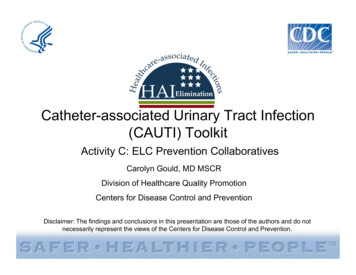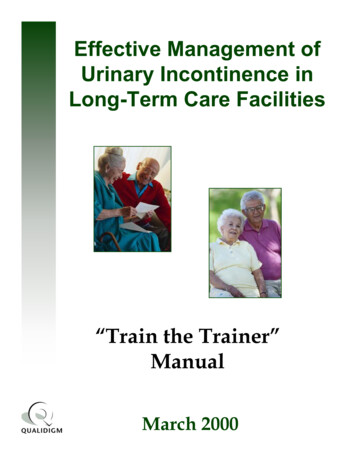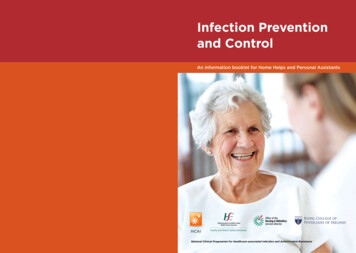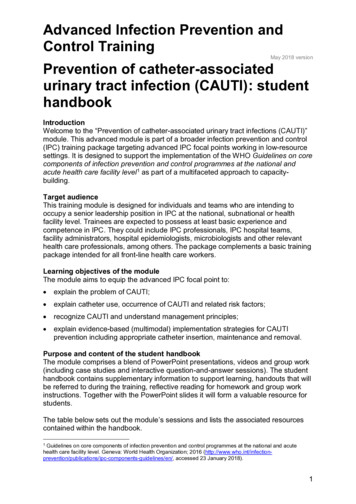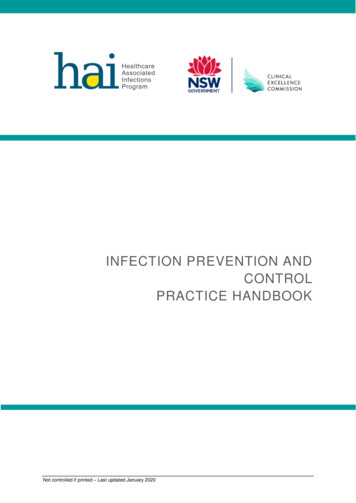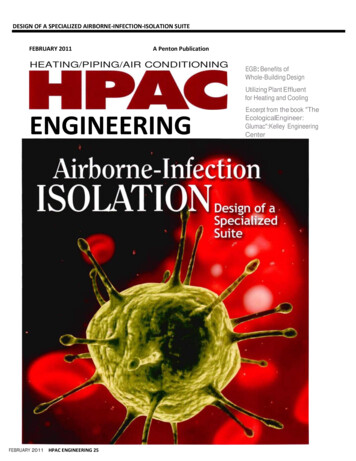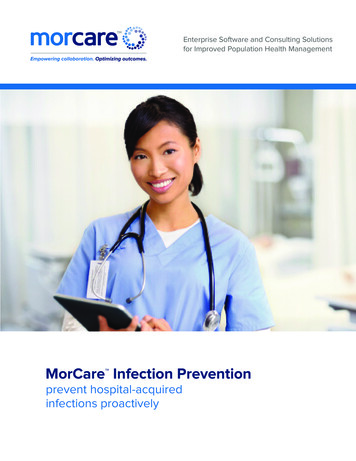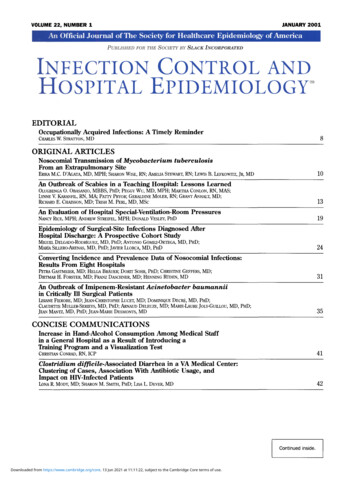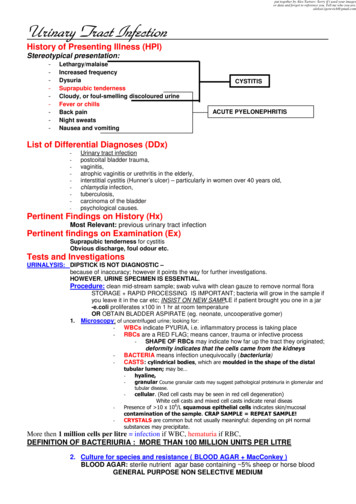
Transcription
put together by Alex Yartsev: Sorry if i used your imagesor data and forgot to reference you. Tell me who you are.aleksei.igorevich@gmail.comUrinary Tract InfectionHistory of Presenting Illness (HPI)Stereotypical presentation:- Lethargy/malaise- Increased frequency- Dysuria- Suprapubic tenderness- Cloudy, or foul-smelling discoloured urine- Fever or chills- Back pain- Night sweats- Nausea and vomitingCYSTITISACUTE PYELONEPHRITISList of Differential Diagnoses (DDx)-Urinary tract infectionpostcoital bladder trauma,vaginitis,atrophic vaginitis or urethritis in the elderly,interstitial cystitis (Hunner’s ulcer) – particularly in women over 40 years old,chlamydia infection,tuberculosis,carcinoma of the bladderpsychological causes.Pertinent Findings on History (Hx)Most Relevant: previous urinary tract infectionPertinent findings on Examination (Ex)Suprapubic tenderness for cystitisObvious discharge, foul odour etc.Tests and InvestigationsURINALYSIS: DIPSTICK IS NOT DIAGNOSTIC –because of inaccuracy; however it points the way for further investigations.HOWEVER, URINE SPECIMEN IS ESSENTIAL.Procedure: clean mid-stream sample; swab vulva with clean gauze to remove normal floraSTORAGE RAPID PROCESSING IS IMPORTANT; bacteria will grow in the sample ifyou leave it in the car etc; INSIST ON NEW SAMPLE if patient brought you one in a jar-e.coli proliferates x100 in 1 hr at room temperatureOR OBTAIN BLADDER ASPIRATE (eg. neonate, uncooperative gomer)1. Microscopy: of uncentrifuged urine; looking for:- WBCs indicate PYURIA, i.e. inflammatory process is taking place- RBCs are a RED FLAG; means cancer, trauma or infective process- SHAPE OF RBCs may indicate how far up the tract they originated;deformity indicates that the cells came from the kidneys- BACTERIA means infection unequivocally (bacteriuria)CASTS: cylindrical bodies, which are moulded in the shape of the distaltubular lumen; may be hyaline,granular Course granular casts may suggest pathological proteinuria in glomerular andtubular disease.cellular. (Red cell casts may be seen in red cell degeneration)White cell casts and mixed cell casts indicate renal diseasPresence of 10 x 106/L squamous epithelial cells indicates skin/mucosalcontamination of the sample. CRAP SAMPLE REPEAT SAMPLE!CRYSTALS are common but not usually meaningful: depending on pH normalsubstances may precipitate.--More then 1 million cells per litre infection if WBC, hematuria if RBC,DEFINITION OF BACTERIURIA : MORE THAN 100 MILLION UNITS PER LITRE2. Culture for species and resistance ( BLOOD AGAR MacConkey )BLOOD AGAR: sterile nutrient agar base containing 5% sheep or horse bloodGENERAL PURPOSE NON SELECTIVE MEDIUM
MacConkey Agar: sterile nutrient agar with bile salts, lactose and a pH indicator-SELECTIVE AND DIFFERENTIAL;- BILE SALTS inhibit growth of non-enteric organisms- LACTOSE pH indicate organisms which can metaboliselactose; those will show up as PINK-RED COLONIES(the rest will be pale yellow or colourless colonies)*EXTREMELY IMPORTANT to test cultures for SENSITIVITY RESISTANCECOMPREHENSIVE WORK UP for patients who did not respond to short 3day course of antibioticsBLOOD TEST:CREATININE and UREA: increased loss of kidney function(kidneys responsible for eliminating creatinine and urea)ABDOMINAL X-RAY with IV contrast:Assesses kidney physiology function; ?nephritis?)MICTURATING CYSTOGRAM:In children under 4 to check for VESICOURETERIC REFLUXCYSTOSCOPY in older patients will reveal bladder cancerIMAGING THE URINARY TRACT:ULTRASOUND is modality of choicePLAIN X-RAY of limited useINTRAVENOUS PYELOGRAPHY: injected water-soluble dye will circulate throughkidneys and collect in ureters; imaging reveals the calyces of kidney.Disease Definition1. Breathlessness, tiredness and varicose veins due to normal changes in pregnancy Increased energy needs of pregnancy lead to increased appetite, weight gain and metabolicrate hence - tiredness. Progesterone stimulates maternal respiratory centre to increaseventilation - coupled with increasing size of the foetus leading to decrease in diaphragmaticexcursion, both leading to increased respiratory rate. As the basal rate is already increasedthe threshold for breathlessness on exertion is decreased hence - breathlessness. Increasingsize and location of developing fetus leads to increased pressure on venous return fromlimbs hence - varicose veins. Later in pregnancy increased fluid volume leads to dilutionalanaemia contributing to hence - breathlessness and tiredness.2. UTI with minimal symptoms in pregnancy. Urinary stasis due to pregnancy leading to increased susceptibility to infection whenassociated with decreased immunity in pregnancy ? pressure on bladder leads to reflux,with incomplete bladder emptying, leading to bacterial multiplication with breakdown ofurinary nitrates to nitrites, and inflammation, hence increased capillary permeabilityallowing protein into urine along with nitrites.SYMPTOMATIC Management of UTI: uncomplicated CYSTITISFIRST TIME UTI : TREAT with short course (3 days ) of antibiotics; then TEST AGAINRECURRENT UTI: prophylactic antibiotics at night (minute doses)ACUTE PYELONEPHRITIS: 10 to 14 days of antibiotics; hospitalise if vomiting and febrileMAKE DAMN CERTAIN that the antibiotic is WATER-SOLUBLEASYMPTOMATIC BACTERIURIA: just observe UNLESS PREGNANT:UTI IN PREGNANCY: TAKE CARE WITH CHOICE OF ANTIBIOTIC;DO NOT MUTATE THE BABY:1 week-long course of KEFLEX or AMPICILLINAVOID Last semester SULPHONAMIDESQUINOLONESTETRACYCLINESALSO: increase fluid intake and VOID REPETITIVELY AND OFTEN
EpidemiologyUTI’s are common in-women,-people who are immobile and bed ridden (particularly if catheterised)-diabetics-the elderly.*Nosocomial infections tend to be more serious, with more virulent and antibiotic-resistant organisms asopposed to community-acquired UTI’s which are largely caused by E coli. Recurrent infections are associated with considerable morbidity.If complicated, UTI’s can cause severe renal disease including end-stage renal failure. UTI’s are a common source of life-threatening Gram-negative septicaemia.AetiologyInfection is usually due to bacteria from the patient’s own bowel flora.The pathogens that may cause UTI are:-Escherichia coli and other coliforms in approximately 68% of infections-Proteus mirabilis and Pseudomonas aeruginosa in 12% - mostly due to catheterisation;-Klebsiella aerogenes in 4% of infections – most of these are nosocomial;-Enterococcus faecalis in 6% - most of these also nosocomial infections;-Staphylococcus saprophyticus (part of vaginal flora – common in sexually active women),-Staphylococcus epidermidis (part of skin flora – important in colonisation of catheters)-Staphylococcus aureus (usually nosocomial) in 10% of infections;-Candida albilcans (rare except after prolonged bladder catheterization).Transfer to the urinary tract most often occurs via the ascending transurethral route.For the ascending transurethral route there are 3 steps:1) The vagina and periurethral area is colonized by uropathogenic bacteria.-facilitated by the adhesion of bacteria to uroepithelial surfaces by pili or fimbriae present onsome bacterial cell surfaces.-Other factors contributing to the colonization are-the use of a diaphragm and spermicidal jelly,-hormone-deficient vaginal atrophy-systemic antibiotic treatment for non-urinary tract infections.2) Bacteria are transferred along the urethra to the bladder.-This step is facilitated by sexual intercourse or catheterization.-Spontaneous transfer along short female urethra is easy, while the longer male urethra protectsagainst transfer of bacteria to the bladder.-In addition, prostatic fluid has defensive bactericidal properties.3) Bacteria enter and multiply within the bladder.-Urine is normally sterile, however residual urine in the bladder due to incomplete emptying is a risk factor forthe development of a UTI, as urine provides a ‘sterile broth’ ideal for bacterial growth.-In diabetics, the presence of glucose in urine further supports bacterial growth.
-Mucosal defence mechanisms of the bladder are poorly understood. The establishment of infection maybe facilitated by fimbriated bacteria adhering to the bladder uroepithelium. A thin layer of mucopolysaccharidecoats the transitional epithelial cells and prevents adhesion of bacteria.proanthocyanidins, found naturally inCondensed tannins, calledcranberries and blueberries, can prevent and treat UTI’s by furtherblocking the binding of some strains of E coli to the epithelial cells.-In contrast, loss or depletion of the protective mucopolysaccharide coat or the epithelium due toprevious infection, bladder trauma from catheterization or vigorous intercourse may predispose anindividual to infection.After an infection has been established in the bladder, it can spread up the ureters to the kidneys.Several factors facilitate this: vesicoureteric reflux: in which the ureters do not completely drain into the bladder and instead retainsome urine, this can arise if the vesicoureteric junction has a defective valve which allows a jet ofurine to shoot up the ureter when the bladder contracts, or if the angle at which the ureters meetthe bladder in an individual is horizontal rather than oblique. virulence factors of the organism (flagellae, pili, fimbriae, exotoxins etc Staphylococcus aureusinfections of the bladder may rapidly spread to the kidneys and blood, whereas an E Coli bladderinfection may be self-limiting)* dilated hypotonic ureters defective host defences and the absence of antibioticsA UTI is commonly an isolated event (90% of cases) as opposed to a repeated one.*UTI’s can occur in functionally normal or abnormal urinary tracts and it important to determine which is the caseFUNCTIONALLY NORMAL URINARY TRACTS with normal excretion urography:Persistent or recurrent UT’s seldom result in serious kidney damage(uncomplicated UTI)ABNORMAL URINARY TRACTS are those with stones, diabetes mellitus or other diseases which causekidney damage:Infection here may exacerbate pre-existent kidney damage (complicated UTI)UTI, especially with Proteus may predispose to stone formation.The combo of infection obstruction results in severe, rapid kidney damage (obstructive pyonephrosis) andis an important cause of Gram-negative septicaemia.Prevention:2L/day fluid intake !! MOST IMPORTANT !! keep that urine cycling- flow rate will keep bacteria outvoiding at 2-3 hour intervals with double micturition if reflux presentvoiding before bedtime and after intercourseavoidance of bubble baths and bathing in hot spasavoidance of constipation which may impair bladder emptyinggood personal hygiene
Relevant anatomy
Behavioural science of PREGNANCY: biopsychosocial aspectscommon EARLY SYMPTOMS of pregnancy are:- an increase in the size and tenderness of the breasts,- nausea (not necessarily in the morning) and for some women vomiting, first 12 to 14 weeks- Hyperemesis gravidaruum is the term used to describe women who require treatment inhospital for their vomiting.- 0.1% of pregnant women- urinary frequency,- constipation,- backache,- dizziness- fatiguecommon LATE SYMPTOMS of pregnancy are:- urinary frequency,incontinence,- weight gain,- binge eating,- pica,edema,- sweating,breathlessness,- heartburn,hemorrhoidsvaricose veins,- muscle spasmback pain.Most of these can be explained by the size and position of the baby(in relation to the maternal organs)- Women report feeling relaxed and passive and tired.This hormonal effect is protective for growth and development and allows weight gain.predictive of a good outcome and less psychological symptoms are;- whether the pregnancy was wanted (even if not planned),- if the mother feels she has supports available during and after her pregnancy,- if she has good antenatal care,- if her mental health before her pregnancy is good (including no drug or alcohol abuse)- if she is of higher socioeconomic status.fears and worries during pregnancy;. The most common are;- 'will I lose my baby?'- will my baby be normal?'- 'Is my baby still alive?'- 'Will I/we be able to cope with a baby?'- 'Will I be a good enough mother?'- 'Have I done anything to hurt my baby?'- 'Will sex hurt my baby?'- ' Will I lose the weight gained after my pregnancy?good physical outcome of pregnancy isthe birth of a healthy baby of normal weight for sex, age and gestational age and a healthy mother.Intrauterine growth retardation is associated with;- low maternal prepregnancy weight,- failure to gain adequate weight during pregnancy,- smoking cigarettes- excess coffee,- alcohol abuse,- excessive exercise and vomiting.Maternal obesity may be associated with birth of either large or growth retarded babies.
Pregnancy is a challenge to the body image of many women, not only those with eating disordersbefore pregnancy. The increase in blood volume, fluid retention, fat deposition on the thighs andbreasts and in crease in the size of the organs associated with pregnancy all contribute to this challenge.Parents 'at risk' of a poor outcome following childbirth are those who havepoor coping skills,poor relationship with each other,parents who were poor role models,unrealistic expectations of parenthood,baby who is in poor health or 'failing to thrive'those who lose their baby.The risk factors for postnatal depression arepoor perceived supports during and after pregnancy,prior history of depression or other psychological problem, such as an eating disorder.Postpartum depression may be a misnomer as at least one third of women are already depressedduring pregnancy and others do not develop symptoms until a year later.Recovery from childbirth may take many months.Three months after the vaginal birth of their first child 20% of women still feel general discomfortin the vulvovaginal area50% still have some discomfort during sexual intercourse.The recovery time is longer if sutures are required, forceps are needed and other more extensive vagina
If complicated, UTI’s can cause severe renal disease including end-stage renal failure. UTI’s are a common source of life-threatening Gram-negative septicaemia. Aetiology Infection is usually due to bacteria from the patient’s own bowel flora. The pathogens that may cause UTI are:File Size: 1MBPage Count: 9
